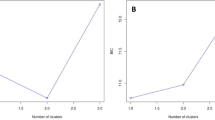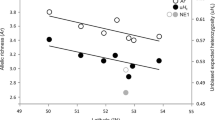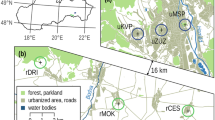Abstract
Because of the extreme ecological and environmental changes along an urban–rural gradient, it has been proposed that urbanised and non-urbanised populations of the same species may be distinctly isolated. There is evidence that urban populations have become significantly different from the original forest populations in several aspects. However, little is known about the extent to which urban and non-urban populations are genetically isolated from each other. We tested the hypothesis of genetic differentiation by comparing the genomic DNA of an urban and a nearby forest-living European blackbird (Turdus merula) population. The present results suggest that, based on amplified fragment length polymorphism analysis, the urban population studied is very similar to a forest population at neutral genetic markers. Thus, despite indications of obvious functional genetic adaptation, the hypothesis of an overall genetic differentiation between our urban and forest populations could not be supported.
Similar content being viewed by others
References
Batten LA (1973) Population dynamic of suburban Blackbirds. Bird Study 20:251–258
Batten LA (1974) Blackbird boom in suburbia. Wildlife 6:274–277
Bensch S, Åkesson M (2005) Ten years of AFLP in ecology and evolution: why so few animals? Mol Ecol 14:2899–2914
Bensch S, Åkesson S, Irwin DE (2002a) The use of AFLP to find informative SNP: genetic differences across a migratory divide in willow warblers. Mol Ecol 11:2359–2366
Bensch S, Åkesson S, Salomon M, Seibold I (2002b) Amplified fragment length polymorphism analysis identifies hybrids between two subspecies of warblers. Mol Ecol 11:473–481
Borowsky RL (2001) Estimating nucleotide diversity from random amplified polymorphic DNA and amplified fragment length polymorphism data. Mol Phylogenet Evol 18:143–148
Erz W (1964) Populationsökologische Untersuchungen an der Avifauna zweier norddeutscher Großstädte. Z Wiss Zool 170:1–111
Excoffier L, Smouse PE, Quattro JM (1992) Analysis of molecular variance inferred from metric distances among DNA haplotypes: application to mitochondrial DNA restriction data. Genetics 131:479–491
Holsinger KE, Lewis PO, Dey DK (2002) A Bayesian method for analysis of genetic population structure with dominant marker data. Mol Ecol 11:1157–1164
Johnston RF (2001) Synanthropic birds of North America. In: Marzluff JM, Bowman R, Donnelly RE (eds) Avian ecology and conservation in an urbanizing world. Kluwer Academic, Norwell, pp 49–67
Johnston RF, Selander RK (1971) Evolution in the house sparrow. II. Adaptive differentiation in North American populations. Evolution 25:1–28
Karhu A, Hurme P, Karjalainen M, Karvonen P, Kärkkäinen K, Neale D, Savolainen O (1996) Do molecular markers reflect patterns of differentiation in adaptive traits of conifers? Theor Appl Genet 93:215–221
Klausnitzer B (1989) Verstädterung von Tieren. Die Neue Brehm-Bücherei, Wittenberg Lutherstadt
Luniak M, Mulsow R (1988) Ecological parameters in urbanization of the European Blackbird. In: Ouellet H (ed) Acta XIX Congressus Internationalis Ornithologici. University of Ottawa Press, Ottawa, pp 1787–1793
Luniak M, Mulsow R, Walasz K (1990) Urbanization of the European Blackbird—expansion and adaptations of urban population. In: Luniak M (ed) Urban ecological studies in Central and Eastern Europe; international symposium Warsaw, Poland. Polish Academy of Sciences, Warsaw, pp. 187–198
Partecke J (2003) Annual cycles of urban and forest-living European Blackbirds (Turdus merula): genetic differences or phenotypic plasticity? Dissertation at the Ludwig-Maximilians-University, Munich
Partecke J, Van’t Hof T, Gwinner E (2004) Differences in the timing of reproduction between urban and forest European blackbirds (Turdus merula): result of phenotypic flexibility or genetic differences? Proc R Soc Lond B 271:1995–2001
Partecke J, Van’t Hof T, Gwinner E (2005) Underlying physiological control of reproduction in urban and forest-dwelling European blackbirds Turdus merula. J Avian Biol 36:295–305
Schluter D, Nagel LM (1995) Parallel speciation by natural selection. Am Nat 146:292–301
Schneider S, Roessli D, Excoffier L (2000) Arlequin, Version 2000: a software for population genetics data analysis. Genetics and Biometry Laboratory, Department of Anthropology, University of Geneva, Switzerland
Stephan B (1999) Die Amsel. Die Neue Brehm-Bücherei Bd. 95, Westarp Wissenschaften, Hohenwarsleben
Sukopp H (1998) Urban ecology—scientific and practical aspects. In: Breuste J, Feldmann H, Uhlmann O (eds) Urban ecology. Springer, Berlin Heidelberg New York, pp 3–16
Tomialojc L (1985) Urbanization as a test of adaptive potentials in birds. In: Ilyichev VD, Gavrilov VM (eds) Acta XVIII Congressus Internationalis Ornithologici II. Nauka, Moscow, pp 608–614
Vitousek PM, Mooney HA, Lubchenco J, Melillo JM (1997) Human domination of earth’s ecosystems. Science 277:494–499
Vos P, Hogers R, Bleeker M, Reijans M, van de Lee T, Hornes M, Frijters A, Pot J, Peleman J, Kuiper M, Zabeau M (1995) AFLP—a new technique for DNA fingerprinting. Nucleic Acids Res 23:4407–4414
Wüst W (1986) Avifauna Bavariae. Die Vogelwelt Bayerns im Wandel der Zeit, vol. II. Ornithologische Gesellschaft, Bayern, pp 1101–1105
Acknowledgements
We thank R. Barth, D. Geue and D. Schmidl for invaluable help during field work and W. Jensen for technical support. A special thank to M. Webster and two anonymous reviewers for useful comments on a previous draft. All experimental procedures were carried out in accordance with the guidelines of the relevant German agencies. J.P. is currently supported by the Alexander von Humboldt-Foundation. Ebo Gwinner was involved in all stages of this study from planning the experiment to writing the first manuscript draft. Unfortunately, he died on 7 September 2004 before our manuscript was finalised.
Author information
Authors and Affiliations
Corresponding author
Additional information
Communicated by F. Bairlein
Eberhard Gwinner died on 7 September 2004
Rights and permissions
About this article
Cite this article
Partecke, J., Gwinner, E. & Bensch, S. Is urbanisation of European blackbirds (Turdus merula) associated with genetic differentiation?. J Ornithol 147, 549–552 (2006). https://doi.org/10.1007/s10336-006-0078-0
Received:
Revised:
Accepted:
Published:
Issue Date:
DOI: https://doi.org/10.1007/s10336-006-0078-0




